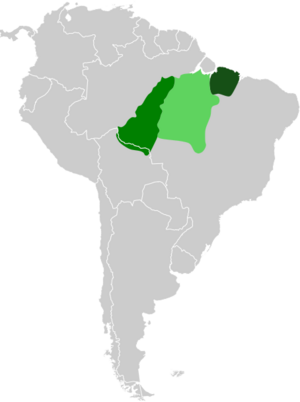Dark-winged trumpeter facts for kids
Quick facts for kids Dark-winged trumpeter |
|
|---|---|
 |
|
| Conservation status | |
| Scientific classification | |
| Genus: |
Psophia
|
| Species: |
viridis
|
 |
|
The dark-winged trumpeter (Psophia viridis) is a special kind of bird that lives only in Brazil. It belongs to a family of birds called Psophiidae. These birds are known for their unique calls, which sound a bit like a trumpet!
Contents
About Its Name and Family
Scientists sometimes have different ideas about how to group animals. For the dark-winged trumpeter, it's a bit tricky! Some experts think there are three main types, or "subspecies," of this bird. These are like different versions of the same species.
The main types are called P. v. viridis, P. v. dextralis, and P. v. obscura. This article will follow the idea that these are all subspecies of the dark-winged trumpeter.
What It Looks Like
The dark-winged trumpeter is a medium-sized bird. It looks a bit like a chicken, but with a long neck and long legs. It also has a slightly hunched back. These birds are about 45 to 52 centimeters (18 to 20 inches) long. Both male and female birds look the same.
Their beaks can be dark brown or even bright green. Their legs and feet are usually dark brown or greenish-olive.
- Main Type (P. v. viridis): This bird is mostly a velvety black color. It has a dark, smoky olive-green patch on its back and wings. You might also see a shiny purple patch on its lower neck.
- Olive-winged Type (P. v. dextralis): This one has a dark brown back and wings. The wing patch is olive green towards the end. It doesn't have the shiny colors on its neck or wings.
- Black-winged Type (P. v. obscura): This type looks very much like the olive-winged one. But it has a tiny bit of purple shine on its lower neck and wings.
Where It Lives
The dark-winged trumpeter lives in the Amazon Basin in Brazil. This is a huge rainforest area south of the Amazon River. Different types of the bird live in different parts of this region.
- The P. v. viridis type lives in the western part, between the Rio Madeira and the Rio Tapajós rivers.
- The P. v. dextralis type lives from the Tapajós River to the Rio Tocantins.
- The P. v. obscura type lives from the Tocantins River all the way to the Atlantic coast in the state of Pará.
There have been a few possible sightings in northeastern Bolivia. But scientists are not yet sure if the bird truly lives there.
How It Behaves
Moving Around
Scientists believe that dark-winged trumpeters usually stay in one area. They are also thought to be very protective of their territory, just like other trumpeter birds.
What It Eats
These birds often look for food in groups. A group can have up to about 20 birds. They eat many different things. Their diet includes fruit, insects, small animals, and even dead animals. Sometimes, they follow swarms of army ants. This helps them catch small creatures that are trying to escape the ants.
Making a Family
We don't know much about how dark-winged trumpeters raise their young. They seem to have their breeding season from January to April. Other trumpeter birds are known to be "polyandrous." This means one female bird mates with several male birds. They also work together to raise their chicks. They usually make their nests in holes in trees that other birds have made.
Its Calls
All trumpeter birds are very vocal. The dark-winged trumpeter has a special song. It sounds like a series of low humming notes. They start one at a time, then come in pairs. They also make other sounds. These include harsh, sharp, or loud "tset" notes. They use these calls to stay in touch with each other or to warn of danger.
Its Future
The dark-winged trumpeter is facing some challenges. Different scientific groups classify its risk level differently.
- The "green-winged" type (viridis) is considered Vulnerable. This means it could become endangered if things don't change.
- The "olive-winged" type (dextralis) is Endangered. This means it's at high risk of becoming extinct.
- The "black-winged" type (obscura) is Critically Endangered. This is the highest risk level, meaning it's very close to extinction.
The exact number of these birds is not known. But scientists believe their populations are shrinking. The biggest threats to these birds are deforestation (when forests are cut down) and hunting.


